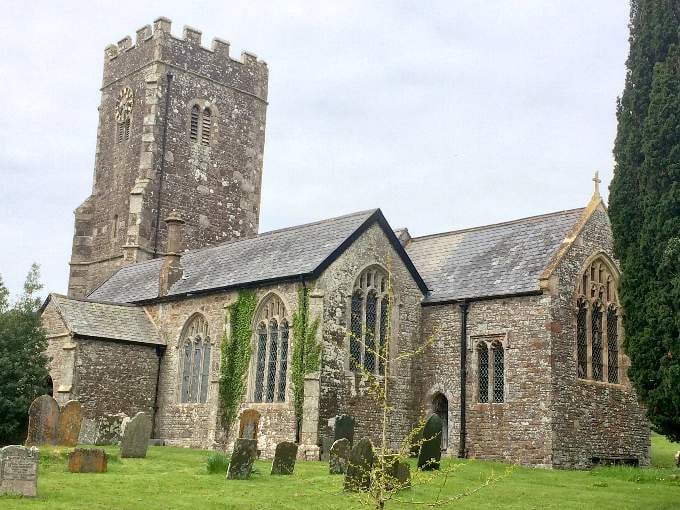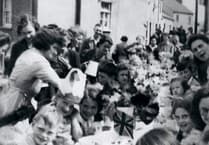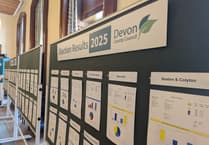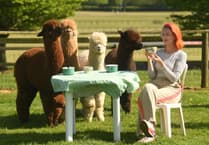Coldridge. Was John Evans really Edward V? Were the Princes not murdered at the hands of Richard III?
FOR more than 100 years historians have puzzled over the identity of John Evans, Lord of the Manor and Deer Parker at Coldridge, and why there was a very rare stained glass portrait of the Missing Prince Edward V in St Matthew’s Church at Coldridge.
As part of British writer Philippa Langley’s "The Missing Princes Project", a team of local amateur researchers have been investigating this. As well as the Coldridge investigation there are 110 separate lines of investigation taking place worldwide under TMPP.
The Coldridge team have recently discovered clues in the church and also historical events that suggest John Evans may have really been Edward V, who had not been murdered in the Tower, and had gone to ground in Coldridge following possible agreements with Richard III and/or his successor Henry VII.
HISTORICAL EVENTS
Today, Wednesday, December 29, details of the news have been revealed publicly with a full report published in "The Daily Telegraph".
Historian John Dike, from Coldridge, has been researching the history of Coldridge Parish Church and discovered many interesting facts which have contributed greatly to the investigations.
He told the Courier: "In March 1484 Richard III did a deal with Elizabeth Woodville, the mother of the Princes, and she left the sanctuary of Westminster Abbey with her daughters.
"Her eldest son, Thomas Grey, who owned lands in Devon and in particular the Manor and Deer Park at Coldridge, had previously fled sanctuary and would join forces with Henry Tudor (later Henry VII) in Brittany.
"Two days later Richard sent Robert Markenfield, a servant and associate, down from Yorkshire to the tiny village of Coldridge.
"However, the brother of Robert, Sir Thomas, another close ally of the King, was given significant lands in the South West and money.
"It is possible that Robert was given the task of controlling the young Edward V on the land attained by the King, from the half brother of the Prince, Thomas Grey."
John continues: "In 1487 Henry VII fought the Battle of Stoke Field and vanquished an army led by a young man, named historically, as Lambert Simnel, but who had been crowned in Dublin as King Edward. This man was led from the field, possibly injured, and was recorded as having the real name John. This may have been Edward V but reverting to the character John Evans before being allowed to return to Coldridge.
"In 1497 there was another rebellion and an army came up from Cornwall led by a person claiming to be the other Prince in the Tower, Richard of Shrewsbury.
"He was later named as Perkin Warbeck. John Evans’ neighbour, and associate, Sir John Speke, was heavily fined by Henry VII for assisting Warbeck.
"It is thought that Warbeck/Richard may have been given hospitality in the Coldridge area, as he would have passed through Crediton to attack the north gate at Exeter, and may have hatched a plan with his brother Edward V, who had been too badly injured at Stoke to take back the throne from Henry VII.
"Warbeck’s attack on Exeter failed. Robert Markenfield had also been associated with the Speke’s.
"By 1511 we know that John Evans had settled at Coldridge and was the Lord of the Manor and Parker of the Deer Park. He had carried out extensive works to the church and erected a stained glass portrait of Edward V which is remarkably only the third such one that exists anywhere."
CLUES IN THE CHURCH
Mr Dike explains that he and the investigation team have identified many items in the church that could link John Evans with Edward V and the church with the House of York.
He explains: "The remarkable Edward V window had been placed in the Evans Chantry. The chantry is all about praying for the donor of the chantry to hopefully speed him through the fires of purgatory.
"There is a large royal crown floating over the Edward V portrait, which it is believed, may have originally been in the larger chancel window. This crown is typical of those placed over a royal coat of arms, which you would not expect to find in an isolated rural church.
"This crown has the Falcon and Fetterlock motif of Edward V. Most unusually this crown has an ermine lining with ermine spots which are in the image of deer not the usual stoats’ tails. Also these 41 deer link back from 1511, when the window was believed to be finished, to 1470, the year Edward V was born, and there is a clear link here between royalty and the deer parker.
"The effigy of John Evans on the tomb has a deep scar across the chin which would cause the teeth to be exposed and cause difficulty in articulation. Was this an injury received by Edward V at Stoke?
"There is a fragment of a stained glass portrait in the chantry which shows a man, similar in appearance to the tomb effigy, who is carrying but not wearing a royal crown, and has an ermine collar only worn by royalty. This image also shows a scar on the chin and damage to the lips exposing the teeth. Experts believe it was drawn from life.
"This links the John Evans tomb to a royal person who was never officially crowned.
"On the tomb the name John Evans is incorrectly spelt EVAS. EV could be Edward V and AS could be an abbreviation of ASA which is latin for ’in sanctuary’.
"Below this inscription is the inverted word KING, possibly medieval graffiti, with nine lines that could symbolise 1509 the year that Henry VII died and Edward V could have reclaimed the throne.
"There are other inverted messages in the church. In the Rood Screen there are three separate small inverted carvings of a Tudor Lady with a long tongue. This could possibly be a swipe at Margaret Beaufort, largely responsible for putting Henry VII on the throne.
"Symbolism linking the church to the House of York (Edward IV, Edward V) is everywhere.
"In the medieval floor tiles and roof bosses there appears the Rose of York motif and the Sun in Splendour.
"In particular, one post reformation salvaged piece of stained glass, showing the Sun in Splendour, has been placed adjacent to the only roof boss with the same image. Clearly a message being handed down."
The location of the church is believed to be significant.
Mr Dike concludes: "To have all these symbolic details in such a remote and inaccessible church, which in 1500 would have only been accessed by cart track, and is right in the centre of rural Devon, suggests the presence of a person of importance.
"An ideal location for Thomas Grey, with the probable agreement of Richard III or later Henry VII, to place his half brother out of the political arena."
Local residents believe that the detail revealed in this research is likely to attract many visitors to the Parish Church and area.





Comments
This article has no comments yet. Be the first to leave a comment.